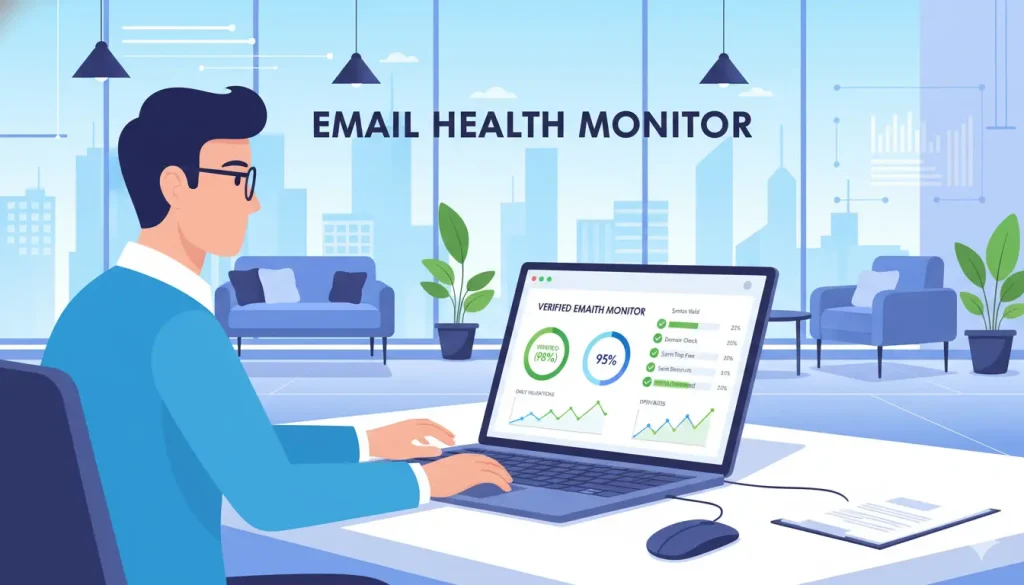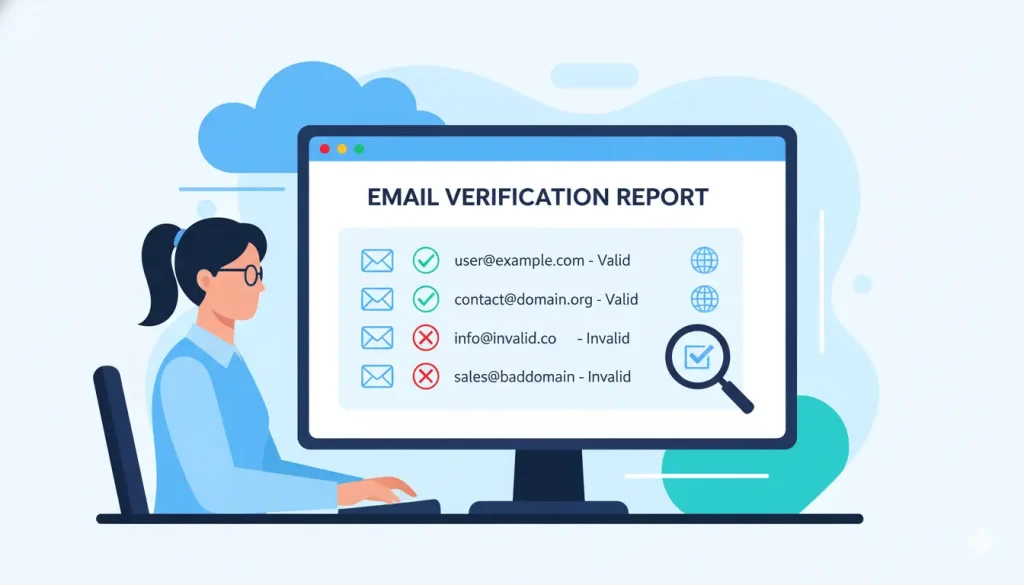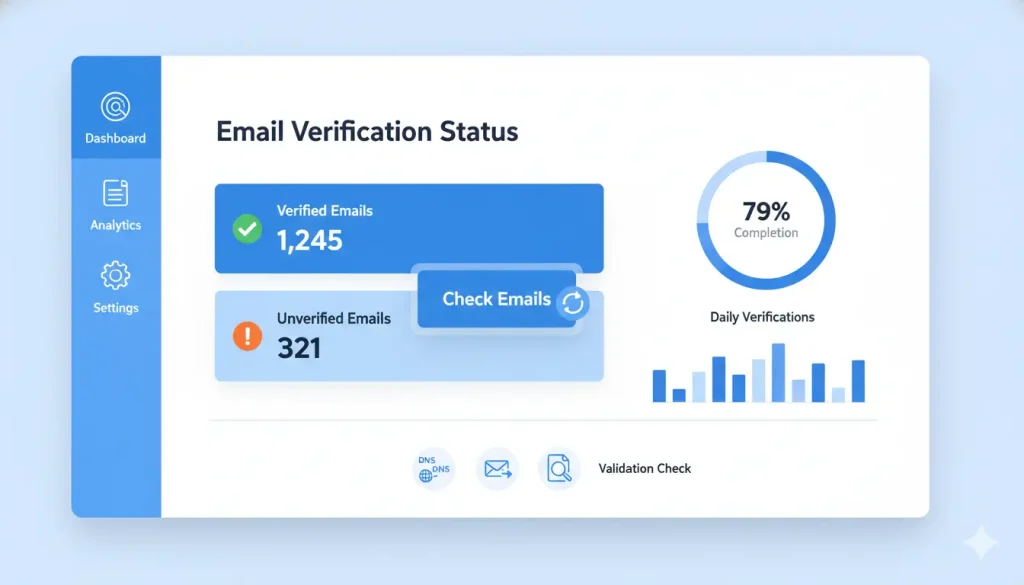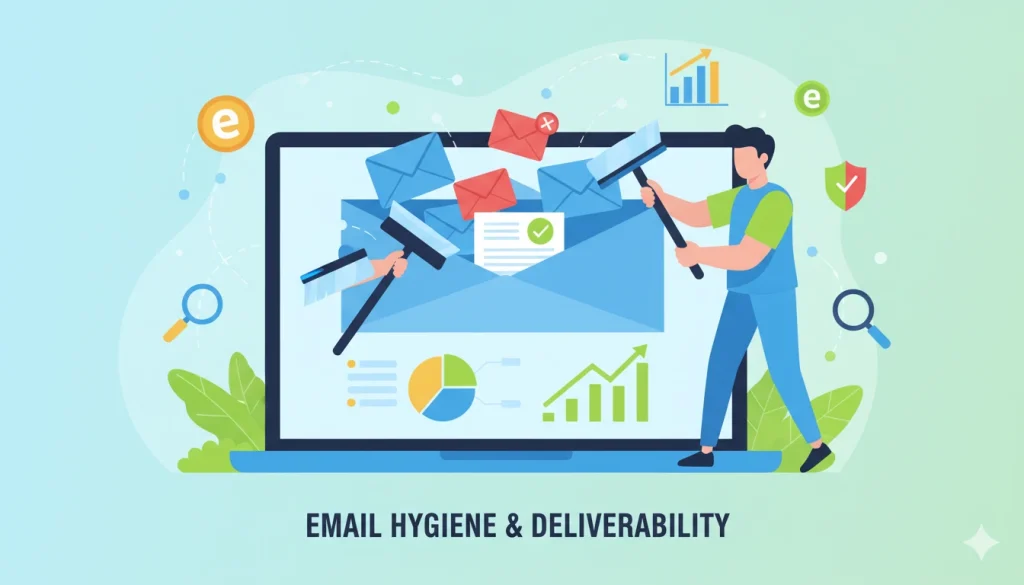When you’re sending emails—whether it’s onboarding users, closing deals, or nurturing leads—you can’t afford to guess if an address is real. Every invalid email costs you in bounce rates, deliverability, and reputation. That’s why learning how to check if an email address is valid isn’t just a technical chore; it’s a business skill. In this guide, we’ll break down exactly how to do it, from simple visual checks to professional-grade verification methods. You’ll learn how experts confirm if an address can actually receive mail—and how you can do it too, without wasting time or resources.
Valid Can Mean Different Things—Let’s Align First
Before you check an email, you need to know what “valid” really means. A valid address can mean three different things, depending on what you care about—format, deliverability, or permission. If you confuse these, you’ll miss key issues that cost you accuracy or compliance.
Syntax vs. Deliverability vs. Permission—What’s The Difference?
Syntax is simply a structure. If the email looks like name@example.com, it passes the first test.
Deliverability digs deeper—it asks, “Can this address actually receive mail?”
Permission goes beyond tech: “Do I have the right to email this person?”
What Counts As “Good Enough” For Your Use Case?
If you’re collecting leads, a syntax check might do. But if you’re sending campaigns or invoices, you’ll need deliverability checks. The deeper the relationship, the deeper your validation should go.
Quick Wins You Can Do In Seconds
Now that you know what “valid” means, let’s start with quick checks you can do right away. These won’t require tools or code, yet they’ll filter out most bad entries.
Human-Eye Checks: Typos, Extra Spaces, And “.cmo” Moments
Look for small errors like gmial.com or an extra space at the end. You’d be surprised how often users mistype their own address. Correcting these early saves hours later.
Smart Regex Without Overfitting: Guardrails, Not Handcuffs
A regular expression (regex) can automate syntax checks. Keep it simple. Don’t try to match every possible address; just ensure there’s text before and after “@” and a valid domain extension. Overly strict rules often reject real users.
Free Cues In The Address: Plus-Addressing, Aliases, And Subdomains
Addresses like name+promo@gmail.com are real. Many people use these to filter or track sign-ups. Recognize them as valid and respect their intent. It helps you keep clean data and trust with your users.
The Domain Tells A Story—Listen To It
Even if an email looks perfect, its domain can expose deeper problems. This is where you move from basic checks to meaningful ones.
Is The Domain Real? WHOIS, Age Clues, And Parking Patterns
Start by checking if the domain actually exists. A WHOIS lookup shows if it’s registered and active. A domain created yesterday might signal spam or fraud. Domains that redirect to parked pages are another warning.
DNS Essentials: A, AAAA, And MX Records At A Glance
If the domain lacks MX (Mail Exchange) records, it can’t receive mail. Use online tools or command-line utilities like nslookup or dig to verify these records. Seeing valid MX entries usually means the domain can handle incoming messages.
Disposable & Temporary Domains: Spotting Burners Without False Positives
Some users sign up using disposable emails like mailinator.com to get a one-time download. You can spot these through public lists or automated APIs. Don’t instantly block them—context matters—but be aware they’ll bounce or vanish soon.
Going Deeper: Mail Server Reality Checks
At this stage, you’re not just looking at the address—you’re testing if it truly works. These checks get closer to real-world deliverability.
MX Lookups: Which Servers Claim They’ll Take Mail?
An MX lookup confirms which servers handle incoming mail for the domain. If none exist, the address can’t receive email. That’s an instant fail.
SMTP Handshake (Without Sending): VRFY/RCPT-TO And Etiquette
This step mimics the first few seconds of sending an email. You “knock” on the mail server and see if it responds that the address exists—without delivering a message. Some servers block these pings to prevent abuse, so use them carefully and ethically.
Catch-All Domains: Why “Accepts Everything” Isn’t A Green Light
Some domains are set up as catch-alls, meaning they accept mail for any username. It sounds great, but it hides invalid users. These often lead to high bounce rates later. Treat them as uncertain until confirmed through engagement or verified response.
Signals From Authentication: SPF, DKIM, And DMARC
You have an address that looks fine and resolves. Now check whether your mail is likely to land where it should. These signals influence email deliverability and trust.
SPF lists the servers allowed to send for a domain. If it is missing or overly broad, filters get nervous. DKIM adds a cryptographic signature that proves the email message was not altered in transit. DMARC sets the policy that tells receivers how to treat failures.
Look at the DNS records for each control. Confirm alignment between the visible From domain and the authenticated domains. Tight alignment helps sender reputation more than any checkbox setting.
Some email service providers publish templated records. Use them, then test. If you manage your own stack, verify that each smtp server is authorized and signing correctly. Check domain records when something changes in routing or infrastructure. Small errors here create big headaches later. Fixing authentication is one of the fastest ways to improve deliverability without changing copy or cadence.
Role Accounts, Group Aliases, And Shared Inboxes
Not all valid addresses belong to a single person. Some go to teams or systems. Treat them differently.
Role accounts like info@ or support@ may be perfect for support flows yet poor for sales replies. Group aliases route to many people. Ask if the intended recipient is a person who can act, or a queue.
Quick checks help you decide how to handle them:
- If it is a shared gmail alias, expect filtered replies and slower follow-ups.
- If it is tied to a password recovery option, avoid sending promotions.
- If it feeds mailing lists, segment it away from one-to-one outreach.
- If it points to a tool or bot, keep messages short and structured.
These addresses are not bad. They are different. Flag them as potentially risky emails and validate engagement assumptions through small tests. If they perform well for your use case, keep them. If not, route them to a separate email account or workflow and validate before scaling.
Compliance & Consent: Valid ≠ Permitted
A working mailbox is not a green light to send. You still need consent and proof.
Confirm how the contact joined your website or product. Record when and where they opted in. If you inherited an email list, ask for permission again before campaigns. This protects email validity and helps you avoid complaints.
Build habits that reduce risk:
- Honor unsubscribes within minutes.
- Include clear purpose and identity in every send.
- For imports, check email addresses against prior opt-out logs.
- Keep region-specific preferences if you operate across borders.
Noncompliance can negatively impact your domain’s standing even if your data is clean. Regulators care about process. So do filters. Good consent practices save time later when you need to prove your intent. If you cannot document permission, hold the contact, run a re-permission step, or remove it. Protect the list and the brand first.
Real-World Testing: Reduce Bounces Before You Scale
Theory is good. Small experiments are better. Validate your approach before you mail thousands.
Start with a tiny segment and send a test email. Track soft bounces, hard bounces, and complaints. Watch for permanent delivery failures that suggest mismatched authentication or throttling. If metrics drift, pause and adjust.
Use quality controls:
- Seed addresses to monitor inbox placement and spam traps.
- Run a free email checker on questionable segments to verify emails quickly.
- Use an email verifier to score edge cases in a few minutes.
- Clean obvious issues in just a few clicks, then review the results.
If a segment looks messy, create a holdout and compare. Keep a clean email list by removing confirmed failures and role-heavy clusters. Periodic spot checks help you maintain momentum without overpaying. When in doubt, slow down, validate, and then scale. Small, steady improvements today protect your reputation tomorrow.
Build Or Buy Email Checker: Choosing The Right Verification Approach
Once you understand how to verify email addresses, the next step is deciding whether to handle the process yourself or use a dedicated service. This choice depends on your scale, technical skills, and goals.
If you’re managing a few hundred signups monthly, you can manually validate email addresses using built-in checks or a lightweight email validator. You can even track results in Google Sheets to keep your email list clean. But if you’re processing thousands, you’ll need something stronger.
An automated email verification tool or email verification API helps you confirm that each email address exists before it reaches your system. These tools run behind the scenes, testing email address syntax, domain health, and response from the email server.
Look for one with a user-friendly dashboard, real-time results, and additional features like identifying temporary email addresses or disposable email address patterns. It’ll help you avoid invalid addresses, fake addresses, and non-existent domains—without diving into technical details or writing your own application programming interface.
Doing it right saves you from negative consequences later, like deliverability issues or failed incoming emails. When the email is valid, your outreach feels smoother, safer, and smarter.
Playbooks You Can Steal: Common Scenarios
Now that you understand how email validation works, let’s see how to apply it in real-world workflows. Different situations need different levels of checking, depending on the risk and the type of user data you handle.
New-User Signup: Keep Out The Junk
When someone registers, validate email addresses right at the form level. Catch invalid email addresses early to prevent fake signups and future support headaches. A quick check helps you display a clear error message if the address doesn’t meet the proper format or if common typos appear. This simple step also filters invalid address patterns before they pollute your database.
Lead Imports: Protect Your System’s Health
If you’re uploading a batch from spreadsheets or CRMs, run an email validation sweep first. It helps weed out invalid email addresses from valid email addresses before they reach your automation or CRM. The cleaner your imports, the fewer delivery issues with major email providers like Gmail, Outlook, or Yahoo.
Pre-Campaign Scrub: Confidence Before You Hit “Send”
Right before a big send, run another check. Even lists that were clean months ago can decay. People change jobs, switch domains, or abandon inboxes. A final pass ensures each email is valid, reducing bounces and protecting your sender reputation across email providers.
Your Next Step, Without Guesswork
Checking if an email address is valid doesn’t have to feel complicated. Once you understand what to look for—syntax, domain health, and server response—you can catch most issues before they cause damage. Whether you validate addresses manually or automate the process, consistency is what keeps your data clean and your deliverability strong. Start small, test your methods, and scale what works.
Suppose you’d rather automate the heavy lifting. In that case, our email verification service handles everything behind the scenes—accurately, securely, and without slowing you down—so you can focus on building connections that actually reach the inbox.





